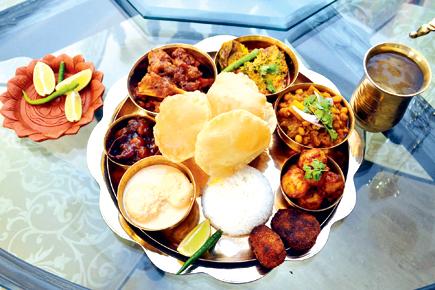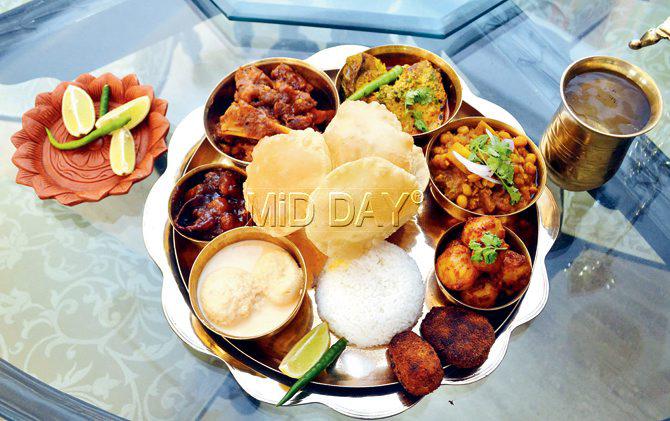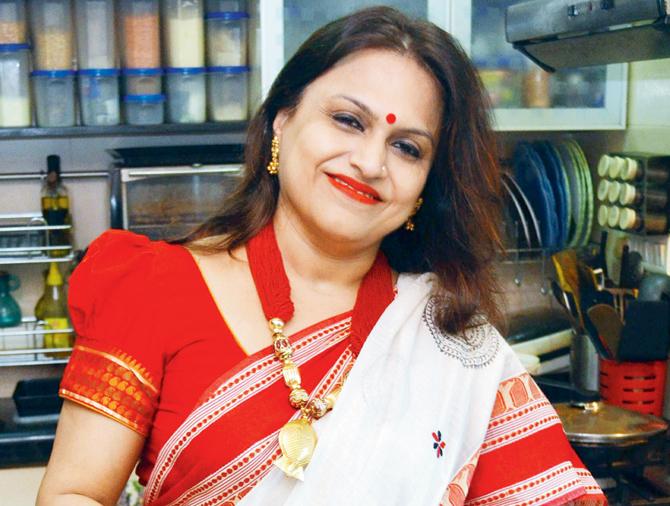With rising interest in regional cuisine, Bengali fare ranks high on the list. Mumbai-bred Bengali foodie, Suprita Mitter sampled meals from two such pop-ups, and drew up her report card

Thali
Last weekend, Home Chef organised Maach and Mishti (Rs 999), by Dolly Singh, and Ananya Banerjee hosted a home pop-up (Rs 1,500), serving traditional Bangla fare. Here’s how they fared on our experience meter.
ADVERTISEMENT

Dolly Singh’s thali featured (centre) white fluffy rice served with Moong Dal, (clockwise from top right) Chingri Phoolkopi Dalna, Karela Aloo Bhaja, Muri Ghonto, Tomato Chutney, Saag Chutney, Maach Makha and (in bowls, from top) Rohu Kalia and Payesh. Pic/Sharad Vegda
Rating: 3/5

Dolly Singh
While Banerjee has spent most of her life in Mumbai, apart from her early schooling in Kolkata and a short stint in Germany, Singh (who is a Bihari), was born in Kalimpong, West Bengal. Both chefs believe that regional cuisine has so much diversity that there is no need to experiment. Their hope is to bring back recipes passed on from generations.

The thali featured (clockwise from left) Rossogollar Payesh, Aam Shotto Khejurer Chutney, Kosha Mangso, Shorshe Maach, Mangshor Ghugni, Alu Dum, vegetable chop, fish chop and (in centre) Gobindo bhog rice and luchi. Pics/Datta Kumbhar
Rating: 4 / 5
Signing up: It was easy to sign up for both pop-ups. The menu details, the venue and the cost are easily available on their Facebook pages. Also, depending on the company that curates a particular experience, you might find details on Bookmyshow as well. Both home chefs sent their menus as soon as we signed up, so we were aware of what to expect.
Portion sizes: A big thumbs up. Both meals served us portions that could suffice for more than one person. Banerjee’s meal included nine items and Singh’s served 10.

Ananya Banerjee
Authenticity and variety: While Singh’s fare included dishes that are a part of daily meals and food that is carried over next day in most Bengali homes, Banerjee helped us sample a home-cooked feast that is whipped up when someone special drops by.
Singh scored higher on nostalgia as the simplicity of her menu reminded us of comfort food from our grandmother’s kitchen. It included Moong Daal (a staple in most Bengali homes), Karela Aloo Bhaja (chopped bitter gourd fried with diced potatoes that balance out the bitterness of the bitter gourd; another traditional favourite), the Maach Makha (de-boned fish pieces in a mish-mash of onions, green chillies and potatoes, spiced with mustard oil; always a last-minute fix in Bengali homes), Saag Chutney (Radish leaves with coconut roasted and pasted on a mortar and pestle), bhaat (fluffy white rice), Muri Ghonto (fish head and rice cooked together), tomato chutney (sweet and sour, leaning on tangy), Rohu Kalia (a thick, spicy, tomato-based fish gravy, flavoured with Bengali garam masala) and Payesh (Bengali-style rice pudding). Our pick of this meal was the Chingri Phoolkopi Dalna (a unique combination of cauliflower and prawns in a mildly-spiced gravy). Its delicate flavours had us going back for a second helping. We wished the Payesh was thicker in consistency.
Some of these dishes, like Maach Makha and Saag Chutney, are difficult to find in Bengali restaurants in the city, and are not made when you are invited to a fancy meal at a Bengali friend’s home. The meal was served on a traditional Shaal Pata plate (plate and bowl made from dried sal leaves) found in Bengal, also used to serve Bhog during Durga Puja.
Banerjee’s meal had items that are easily found in the city’s leading Bengali restaurants during Durga Puja, and also at weddings that opt for a traditional Bengali menu. What sets it apart is that the taste is similar with food that is cooked by your mother.
We started with fluffy white luchis (maida flour puris); for starters, we had fish chops and vegetable chops (breaded cutlets with fish and vegetable filling, respectively). The vegetable chop was a tad too sweet as it included raisins. The Alu Dum (Bengali version of the popular Dum Aloo) was spicy and perfect for our taste buds. The Mangshor Ghugni (mutton kheema cooked with Bengal gram) which has to be eaten with the luchi, was our favourite item from the menu (this is also difficult to find on menus, unless you are invited to a Bengali home).
There was also Gobindo Bhog Rice (small grains of flavourful rice found in Bengal), Shorshe Maach (fish cooked in a mustard curry), Kosha Mangsho (thick, spicy mutton gravy) which are the two most celebrated dishes of Bengal, and Aam Shotto Khejurer Chutney (dried mango or Aam Papad and date chutney, another delicious and rare find).
To wrap things up, we tucked into the Roshogollar Payesh (usually, smaller rasgullas dipped in thick sweetened milk). In this case, however, it was one big rasgulla served in a creamy, thick payesh made with jaggery — a standout winner.
Banerjee’s meal scored an extra brownie point on the taste front. The meal was served in a traditional metal thali.
Overall rating: Both chefs are very talented; it feels criminal to pick favourites as we enjoyed both meals. We applaud Singh who despite being a non-Bengali, managed to whip up the rustic flavours of a simple home-cooked Bengali meal perfectly. Her Phulkopi Chingrir Dalna stole our heart.
We give Banerjee an extra point for the feast that she managed to cook, especially her Aam Shotto Khejurer Chutney, luchi and Mangshor Ghugni.
 Subscribe today by clicking the link and stay updated with the latest news!" Click here!
Subscribe today by clicking the link and stay updated with the latest news!" Click here!






